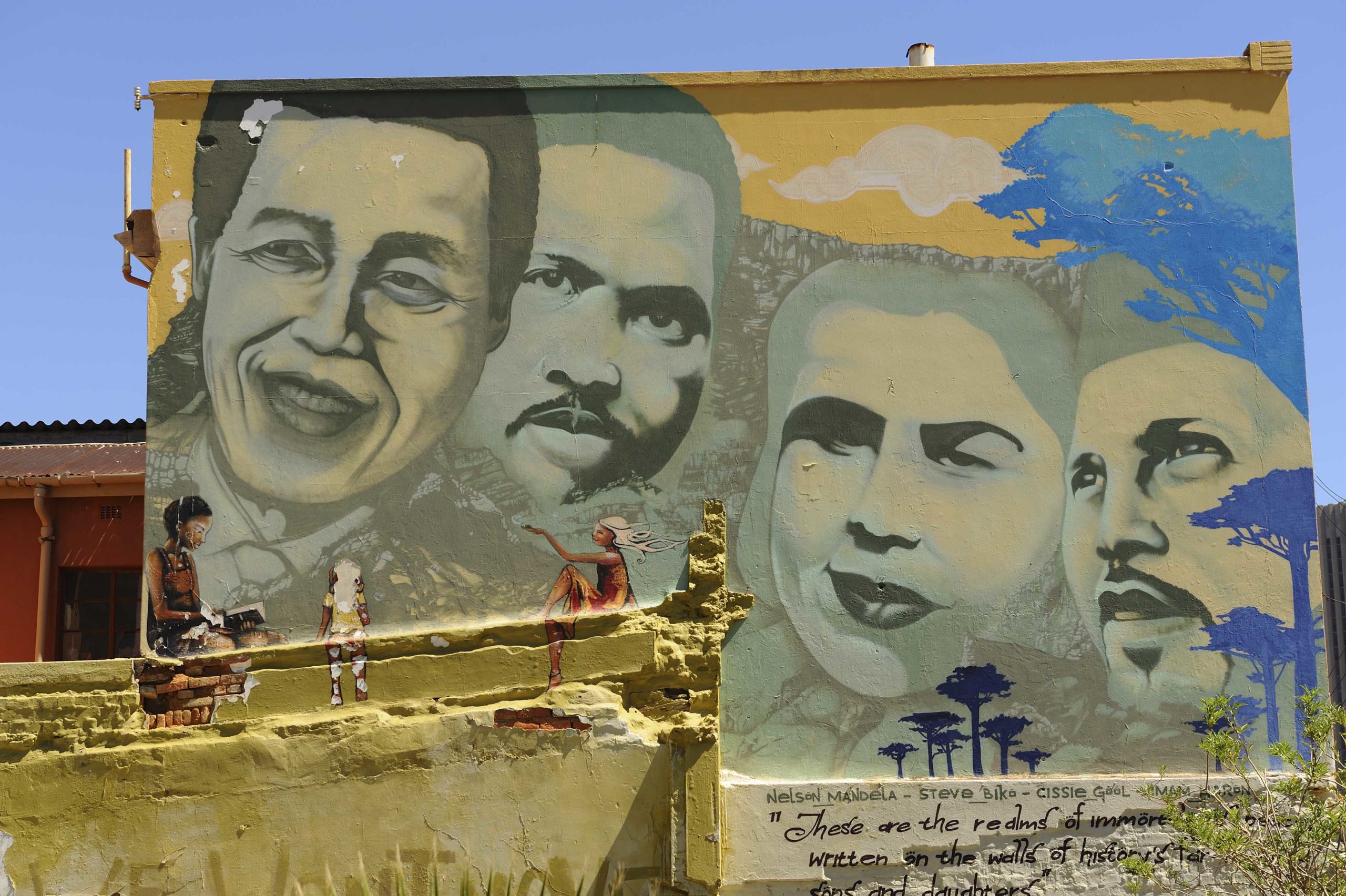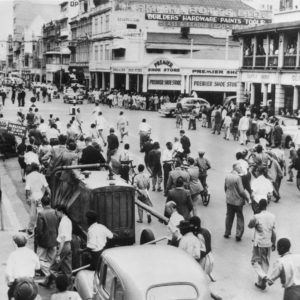The dangerous collapse of non-racialism
Transcending the colonial fabrication of race is a radical idea. Now, as opportunists whip up hatred, South Africa needs to restore this emancipatory horizon.
Author:
30 July 2021

The death toll in the recent riots and the campaign of sabotage that accompanied them is now said to be at more than 330. National attention has overwhelmingly focused on Phoenix, the largely Indian and working-class township in Durban where 16 deaths have now been recorded. This has generated considerable focus on the relationships between Indian and African people.
The pro-Jacob Zuma forces have actively and often effectively sought to exploit the situation by inflaming it at every opportunity. There has been constant circulation of fake news and inflammatory statements on social media, often carefully calculated to incite as much fear and anger as possible. Unfortunately, many politicians, journalists and intellectuals have been swept up in the frenzy and contributed more heat than light.
There is a febrile atmosphere in which paranoia is escalating, the crudest racial language has been used and there appears to be impunity for openly circulating threats to murder people at random, even children. Much of this is wildly divergent from ordinary life in Durban, in which there are all kinds of everyday conviviality along with enduring divisions.
Committing to non-racial politics
It may be useful to step back and offer some wider context to the situation in Durban. We all know that the apartheid system used Indians as a “buffer” race between whites and Africans and offered Indians better treatment than Africans in significant respects. This escalated with the failed attempt to win consent for the tricameral system in the 1980s.
We also know that for a long time Indians and Africans were politically organised on a segregated basis with Indians in the Natal Indian Congress (NIC) and Africans in the African National Congress (ANC). The racist views expressed by Mohandas Gandhi, the founder of the NIC, during his time in South Africa are well known too. So too are the anti-Indian views of Anton Lembede, the founding president of the ANC Youth League.
Membership of the ANC was solely for people defined as Africans by the apartheid state until 1969. People who would not have been classified as African under apartheid were only allowed to be elected into leadership after the 1985 Kabwe conference.
Related article:
The ANC’s commitment to non-racialism after this point was not absolute. Figures like Peter Mokaba and Fikile Mbalula expressed openly anti-Indian views. There have also been forms of chauvinism against people designated as coloured by the apartheid government, perhaps most notoriously expressed by Mzwanele Manyi.
But a more serious commitment to non-racialism was forged elsewhere. In the Congress tradition it was the South African Communist Party and later Umkhonto weSizwe and the ANC underground that built non-racial forms of politics. People such as Yusuf Dadoo, Lenny Naidu and Phyllis Naidoo offered exemplary commitment.
The emergence of the Black Consciousness movement in Durban provided a major challenge to thinking about race in terms of colonial categories, and a sharp generational break between younger Indian activists and the older generation in the Natal Indian Congress.
The Black Consciousness movement considered all people who were not classified as white to be Black. In other words, Blackness became a political identity. In 1972, Rubin Phillip, who is of Indian descent, was elected as Steve Biko’s deputy in the South Africa Students’ Organisation (Saso). Phillip, who went on to become an Anglican bishop inspired by the radical educationalist Paulo Freire, the Black theology of James Cone and the liberation theology of Gustavo Gutiérrez, remains politically active today.
Related article:
In 1973, younger and still more radical figures took centre stage when Saso famously organised a rally in support of Frente de Libertação de Moçambique (Frelimo) or the Liberation Front of Mozambique at the storied Curries Fountain sports ground in Durban. The young Turks arrested after the rally included people such as Aubrey Mokoape, Muntu Myeza and Patrick Lekota; and Strini Moodley and Saths Cooper, both of Indian descent.
In the early 2000s, Moodley, who has since died, would often regale young activists with stories of the tensions between the young radicals in the Black Consciousness movement and Fatima Meer, the doyen of the Natal Indian Congress. In fact he said that they used to break up her meetings, which they saw as “flat-footed tribalism”.
Nineteen seventy-three was also the year of the Durban strikes, and the beginning of the revival of the Black trade union movement. Along with white radicals such as Rick Turner and David Hemson, young Indian radicals, including Omar Badsha, were also swept up in the ferment. In 1985, Jay Naidoo, who also had political roots in Saso, was elected as the secretary general at the launch of the Congress of South African Trade Unions in Durban. The trade union movement mobilised millions of people at its height and was a powerful force in building a popular non-racialism.
Related article:
People of all races joined the United Democratic Front (UDF), launched in Cape Town in 1983. The UDF also mobilised millions of people and, although it was not without its challenges and disagreements, was also a powerful force in building popular non-racialism.
There was also significant Indian participation in smaller but still significant political formations. Abu Baker Asvat, a founding member of the socialist and Black Consciousness party the Azanian People’s Organisation, came to be known as “the people’s doctor”. He was held in very high regard in the Black Consciousness circles of the 1980s. But he is seldom spoken about today because it has been suggested that Winnie Madikizela Mandela ordered his murder in 1989. Many people prefer to gloss over this history because it remains potentially racially explosive.
The non-racial political tradition formed in all these organisations was always imperfect, but it was a major political achievement, and one that drew in all the leading Indian intellectuals and many ordinary people. Of course, it is not true, as many often imply, that Indians were uniformly opposed to apartheid. There were, as was the case in all Black communities, many collaborators, and many ordinary Indians internalised the colonial system of racial hierarchy and deferred to whites while considering themselves superior to Africans.
Racism’s creep
But now much of what was achieved in the past, particularly in the 1970s and 1980s, has been eroded. There has been some economic deracialisation among elites in KwaZulu-Natal. The rich spend their time together in places like Zimbali in Durban and Camps Bay in Cape Town. There has also been some deracialisation among the impoverished who often live close to each other, share the intimacies of neighbours and are increasingly forming families together. But many middle-class and better-off working-class Indians continue to live in little racial bubbles. Racism is not uniform in these little bubbles, but it certainly exists and is not always challenged with sufficient directness and vigour. These days the leading strata of Indian society tends to identify itself as Indian rather than Black, and with the globalisation of Indian culture through Bollywood there is often a much stronger identification with India than there was in the past.
But there are push factors as well as pull factors towards a greater sense of a Indian identity. The key push factor is the rise of a crude and open anti-Indian politics. The most noxious personality driving this today is Julius Malema. The fact that the ANC has not shown any willingness to hold the line against a turn to a politics of crude chauvinism has made many Indian people feel anxious, fearful for the future and no longer certain that de jure citizenship guarantees de facto citizenship. Fears are often expressed that Malema may turn out to be “another Idi Amin”.
At the same time Indians are sharply divided by class, religion and ethnicity. There is no overall leadership, and the leaders that claim to speak for various groups are often self-appointed. In some cases, they are common opportunists. In the absence of any kind of progressive leadership there is no organised way to oppose and isolate racists, and this creates fertile ground for reactionary forms of politics to emerge.
Related article:
The most alarming development in the turn to the Right is the entry of the fascist Bharatiya Janata Party (BJP), the ruling party in India, into South African communities. This follows a similarly ominous development in Mauritius. The BJP has a presence in Phoenix. A party that has its ideological roots in Nazism and is an unapologetically Hindu supremacist organisation can only do terrible damage to the social fabric in South Africa. But without significant organising and credible intellectual and political leadership, there is no clear basis for coherent opposition to entry of a fascist form of Indian politics into South Africa.
The non-racial project rapidly decayed after 1994 for two primary reasons. The first was that it had always been rooted in the practice of political work, and especially mass politics. But party politics became an unseemly scramble for personal power and the demobilisation of community organising and the co-option of the trade unions meant that there were no longer opportunities for ordinary people to participate in political work, and to learn and grow in political organisations.
The second reason for the rapid decay of the non-racial ideal was its co-option by liberalism. Desmond Tutu coined the phrase “rainbow nation”, and Nelson Mandela, who had gone to prison before the emergence of mass-based forms of non-racial political organisation and participation, enthusiastically picked it up. The radical meaning of the idea of non-racialism was largely abandoned but the term “non-racialism” was swiftly incorporated into the very different liberal idea of the rainbow nation. White liberals were thrilled and used this Disneyesque form of facile multiculturalism to prevent Black people from speaking and acting against racism.
Related article:
But non-racialism was fundamentally a different idea, and practice, to “rainbowism”. Non-racialism meant militant anti-racist action in the present, work to build solidarity on the basis of anti-racism in the present and a vision of a future in which the idea of race, a colonial fabrication, would eventually be transcended so that, in the famous words of Robert Sobukwe, there would be “only one race to which we all belong, and that is the human race”. “Rainbowism” meant that people were still divided into races, which were now said to have magically become equal and racism dispensed with overnight.
The student movement of 2015 issued a very direct challenge to the enduring coloniality of the academy. But it made a major mistake in uncritically accepting the appropriation of the radical idea of non-racialism – an idea central to the thought and practice of people like Biko and Sobukwe – by liberalism in the form of “rainbowism”. The result was that the proverbial baby was thrown out with the bathwater.
The decay and then abandonment of non-racialism is not taking us into a better future. On the contrary, it is taking us into all the dangers and crudities of racial, ethnic and religious mobilisation by opportunists, people known in the academic literature as “ethnic entrepreneurs”. We see this with the entry of the BJP into South Africa, the emergence of the Patriotic Alliance and the ways in which the pro-Zuma forces seek to whip up ethnic and racial sentiment.
It is urgent that the non-racial tradition is restored, and that it is restored in organisation and struggle. If we fail to restore the non-racial tradition there will only be more violence, incitement and hatred.





